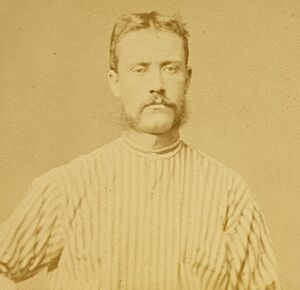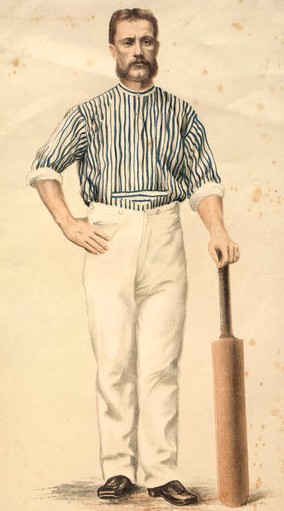Charles Bannerman facts for kids

Charles Bannerman, c. 1870
|
||||||||||||||||||||||||||||||||||||||||
| Personal information | ||||||||||||||||||||||||||||||||||||||||
|---|---|---|---|---|---|---|---|---|---|---|---|---|---|---|---|---|---|---|---|---|---|---|---|---|---|---|---|---|---|---|---|---|---|---|---|---|---|---|---|---|
| Full name |
Charles Bannerman
|
|||||||||||||||||||||||||||||||||||||||
| Born | 3 July 1851 Woolwich, Kent, England |
|||||||||||||||||||||||||||||||||||||||
| Died | 20 August 1930 (aged 79) Surry Hills, New South Wales, Australia |
|||||||||||||||||||||||||||||||||||||||
| Batting | Right-handed | |||||||||||||||||||||||||||||||||||||||
| Bowling | Left arm medium | |||||||||||||||||||||||||||||||||||||||
| International information | ||||||||||||||||||||||||||||||||||||||||
| National side | ||||||||||||||||||||||||||||||||||||||||
| Test debut (cap 1) | 15 March 1877 v England | |||||||||||||||||||||||||||||||||||||||
| Last Test | 4 January 1879 v England | |||||||||||||||||||||||||||||||||||||||
| Domestic team information | ||||||||||||||||||||||||||||||||||||||||
| Years | Team | |||||||||||||||||||||||||||||||||||||||
| 1870–1888 | New South Wales | |||||||||||||||||||||||||||||||||||||||
| Umpiring information | ||||||||||||||||||||||||||||||||||||||||
| Tests umpired | 12 (1887–1902) | |||||||||||||||||||||||||||||||||||||||
| Career statistics | ||||||||||||||||||||||||||||||||||||||||
|
||||||||||||||||||||||||||||||||||||||||
|
Source: CricInfo, 24 April 2020
|
||||||||||||||||||||||||||||||||||||||||
Charles Bannerman (born July 3, 1851 – died August 20, 1930) was a famous Australian cricketer. He was born in England but moved to Australia with his family. Charles was a right-handed batsman. He played for Australia in the very first Test matches between 1877 and 1879. He also played for the New South Wales cricket team. Later in his career, he became a cricket umpire.
Bannerman is most famous for making history in the first-ever Test match. He faced the very first ball bowled in Test cricket. He also scored the first run and the first century (100 runs) in Test cricket. His score of 165 runs in that match is still the highest share of a team's total score in Test history. This is amazing, as over 2,500 Test matches have been played since then!
Contents
Early Life and Cricket Beginnings
Charles Bannerman was born in Woolwich, England. His parents were William and Margaret Bannerman. Soon after he was born, his family moved to New South Wales, Australia.
In Australia, Charles joined the Warwick Cricket Club in Sydney. There, he was coached by William Caffyn. Caffyn was a former player for Surrey County Cricket Club in England. He also played for New South Wales. Charles started playing cricket professionally in 1871. He then made his first-class debut for New South Wales. In his first match, he scored 32 and 3 runs against Victoria.
Making History in Test Cricket
Charles Bannerman played in the first three matches that are now known as Test matches. The very first Test match was between Australia and England. It took place at the Melbourne Cricket Ground (MCG) in March 1877. Australia batted first in this historic game.
Bannerman opened the batting for Australia. This means he faced the first ball ever bowled in Test cricket. The bowler was England's Alfred Shaw. Bannerman also scored the first run in Test cricket. He was dropped (meaning a fielder missed a catch) before he reached 10 runs. But he kept going! He scored 126 runs on the first day. On the second day, he added 39 more runs. He reached 165 runs before he had to stop playing. A ball from George Ulyett broke his finger.
His score of 165 was the first-ever Test century. It is still the highest score by an Australian player in their first Test match. His 165 runs made up a huge part of Australia's total score of 245. This was 67.35% of the team's completed innings. No other Australian player scored more than 20 runs in either innings of that match. Australia won the game by 45 runs. Spectators at the match were so impressed that they collected money for him. They gave him £83 7s 6d as a gift.
Bannerman played in two more matches that are now recognized as Tests. One was later in 1877 and another in 1879. His total Test record was 239 runs. He had an impressive average of 59.75 runs per innings.
At the end of the first Test, Charles Bannerman became the first Test batsman to score 150 runs in his Test career. He finished that match with 169 runs. He also formed the first-ever international batting partnership with Nat Thomson. They scored 2 runs together before Thomson was out.
Charles Bannerman played in the second Test of the 1876–77 series. He opened the batting again with Nat Thomson. They scored 29 runs together before Thomson was out. Charles then batted with Jack Blackham. After 55 minutes, he was bowled out for 10 runs. His career score then increased to 179 runs. In the third Test, he scored 30 runs. This made him the first player to score 200 runs in a Test career, reaching 209 runs.
In 1878, Charles Bannerman went on the first official Australian tour of England. He was the top scorer on the team. He also scored the first century by an Australian player in England. However, no matches on this tour were recognized as Tests. He continued to play for New South Wales until 1888.
Life as an Umpire
After his playing career, Charles Bannerman became a cricket umpire. Between 1887 and 1902, he umpired 12 Test matches in Australia. His first match as an umpire was between Australia and England. It took place at the Sydney Cricket Ground (SCG) in January 1887. England won that match.
Bannerman's last match as an umpire was in Melbourne in 1902. Australia won that game by 32 runs. In two of the matches he umpired, his brother Alick was playing. But no one ever said Charles was unfair.
In a Test match in 1898, Bannerman made an important decision. An English bowler appealed for an lbw (leg before wicket) against Australian batsman Joe Darling. The bowler thought it was an obvious out. But the bowler had run in front of Bannerman, so he couldn't see clearly. Bannerman had to say "not out." Joe Darling was on 50 runs at the time. He went on to score 160 runs, and Australia won the match. After the game, Bannerman complained about the English wicket-keeper. The wicket-keeper had accused him of cheating. The player was told off for his behavior.
In total, Bannerman umpired 58 first-class matches. These were played between 1887 and 1905. In December 1892, he and George Searcy umpired the first-ever Sheffield Shield match. His last matches were in New Zealand in 1905.
Later Life
In the 1922–23 cricket season, a special match was played to help Charles Bannerman. This was the first time a cricket match was broadcast on radio anywhere in the world. From this match, he received £490.
Charles Bannerman passed away in Sydney in 1930. He was survived by his wife, Mary Ann, and five children.


